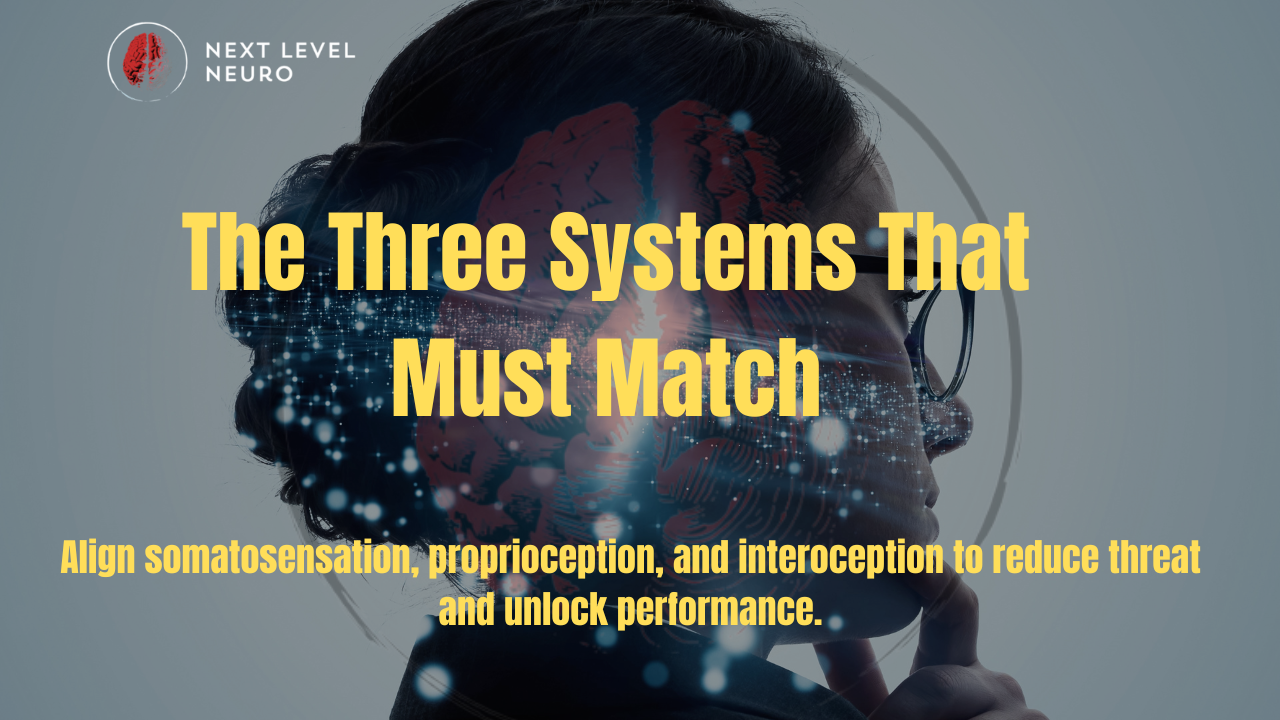The Three Systems Every Therapist Must Integrate: Interoception, Proprioception, and Somatosensation
Oct 14, 2025
If you have ever corrected a client’s form only to watch the same problem return a week later, you are not alone. The issue may not be strength, mobility, or compliance.
It may be sensory mismatch.
Every client’s brain relies on three major systems to understand the world and the body inside it: somatosensation, proprioception, and interoception.
When these systems are calibrated, movement feels fluid, safe, and efficient.
When they conflict, the brain becomes uncertain, and uncertainty always equals threat.
The Three Systems Every Therapist Must Integrate
1. Somatosensation: The Body’s Contact System
Somatosensation tells the brain what is happening on the surface of the body. It detects pressure, temperature, texture, and vibration.
When this system is accurate, clients can interpret physical feedback correctly: how hard they are gripping, how much tension they are using, or when their balance is shifting.
When it is distorted, clients may feel too much or too little.
They overreact to touch or seem numb to input.
For therapists, this might look like hypersensitivity after surgery.
For coaches, it could appear as a client who grips a bar so tightly that they lose endurance.
Improving somatosensation means reintroducing the skin and superficial layers to controlled, meaningful input: light brushing, vibration, temperature contrast, or tactile cueing.
This recalibrates the system and reduces protective overreaction.
2. Proprioception: The Body’s GPS
Proprioception tells the brain where the body is in space. It combines joint, muscle, and vestibular feedback to coordinate movement.
When proprioception is clear, clients can find neutral alignment, maintain control, and move efficiently without relying heavily on mirrors or cues.
When it is inaccurate, movement becomes clumsy and hesitant.
Clients overcorrect, lose balance, or compensate with vision.
For therapists, this shows up as instability after injury.
For trainers, it is the client who looks great in warm-up drills but loses coordination as soon as load or fatigue enters the picture.
Proprioceptive drills such as joint mobility, balance challenges, or closed-eye movements retrain the body’s internal GPS.
3. Interoception: The Body’s Internal Awareness
Interoception monitors what happens inside the body: heart rate, breathing, temperature, muscle tension, and emotional shifts.
It tells the brain if the internal environment is safe or under threat.
When interoception is accurate, clients can regulate their state during stress.
When it is not, they misinterpret normal sensations as danger, leading to anxiety, pain, or movement hesitation.
Therapists might see this as breath-holding or unexplained fatigue.
Coaches often see clients who move fine under light load but shut down under pressure.
Training interoception restores safety to the nervous system.
It allows the brain to stop overprotecting and start performing.
When Systems Mismatch
Pain and performance issues often begin when these systems send conflicting data.
- The skin says “safe,” but interoception says “danger.”
- Proprioception reports balance, but somatosensation signals instability.
- Vision sees symmetry, but the brain feels asymmetry.
The nervous system cannot reconcile the confusion, so it chooses the safest option: restriction, bracing, or pain.
When therapists or coaches learn to align all three systems, clients move better, breathe better, and trust their bodies again.
Practical Integration Example
During a lunge assessment, a client collapses inward at the knee. Instead of cueing “push the knee out,” integrate the three systems:
- Add light tactile feedback (somatosensation) to the lateral knee.
- Include ankle and hip mobility drills (proprioception).
- Pair with slow, conscious breathing (interoception).
Within minutes, the nervous system receives consistent input, and movement cleans up automatically.
For Therapists and Coaches
Whether you use manual therapy, corrective exercise, or strength training, you are always training the nervous system.
When you stop chasing output and start improving input, your interventions become faster and longer lasting.
This is where applied neurology changes everything.
Where to Learn More...
If this topic resonated with you, it is because you already know that real change starts in the nervous system.
Most clients do not need another exercise, cue, or stretch.
They need a clearer signal between their body and brain.
That is exactly what we teach inside Next Level Neuro.
Start Here: The $37 Neuro Advantage Course
The Neuro Advantage Course is your starting point for applied neurology. In less than an hour, you will learn how to assess, test, and train the nervous system to create immediate changes in pain, performance, and regulation.
It is designed for therapists, coaches, and personal trainers who want a simple, step-by-step method that connects the science of the brain to the art of movement.
Go Deeper: The Next Level Neuro Mentorship
For professionals ready to integrate this work fully into their practice, the Applied Neurology Mentorship is where everything comes together.
You will learn how to assess the entire nervous system, apply drills for vision, vestibular, and interoceptive training, and build programs that create long-term transformation instead of temporary fixes.
The mentorship is built for real-world application. You will leave with the skills, systems, and confidence to bring neuroscience to the front lines of client care.
Learn More About the Mentorship →
Next Level Neuro is where therapists, educators, and coaches learn to think like the nervous system. When you train the brain first, everything else follows.
Want more information on our Mentorship and Programs?
We hate SPAM. We will never sell your information, for any reason.

